What Was “The Ranch” on Prairie Creek?
The Hockett Ranch on Tenderfoot Valley Road, Prairie Creek near Joseph, Oregon was composed of three properties: the farm land with attached grazing hills, the timberland on the east slope of Mt. Howard, and grazing lands in the canyon country of The Divide.
Brief Early History
The farm land was purchased sometime in the 1930’s by Dr. C.T. Hockett as a place to put all the animals he was receiving in payment from patients who were too poor to pay their medical bills with cash. When C.T. Hockett passed in 1943 the property went over to sons Jay and Ray. In the 1940’s Ray bought out his brother Jay (who wanted to become a school teacher) and Ray added the Divide and Timber properties.
From our 21st Century perspective it is interesting to look back and understand how values have changed since the farm land and equipment was purchased. Here are the historical figures beginning after C.T. Hockett passed on and Ray Hockett took over.
Historical Land Values and Date of Purchase
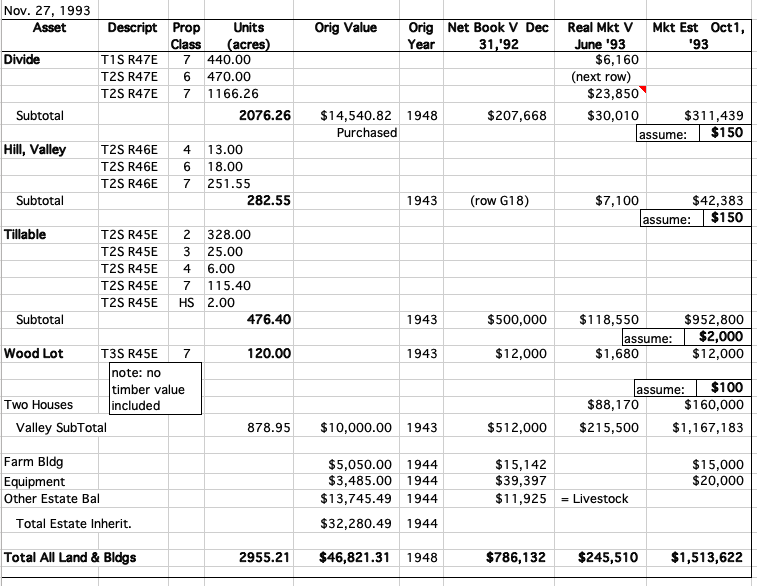
Historical Equipment Values
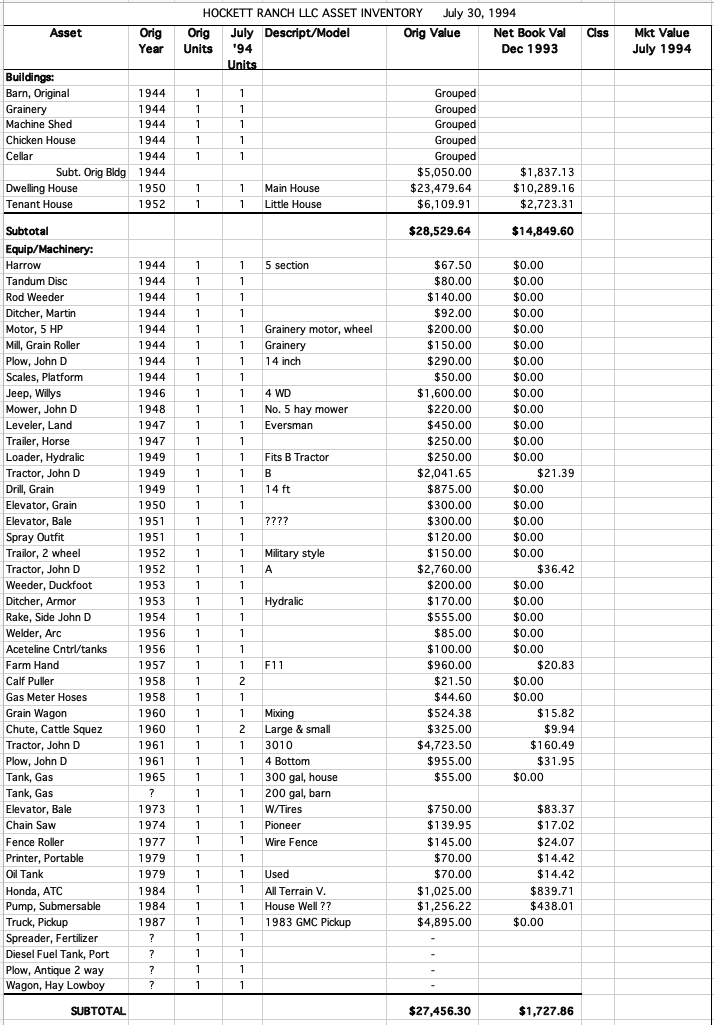
Note that you could purchase over 2,000 acres of range land for $7.00 per acre and you could build a beautiful ranch house with full basement for only $23,479. The hired man’s house was built for $6,109. However, by the time the ranch was sold in 2003 all the equipment except the wheel lines wasn’t worth much.
Locations of Ranch Property
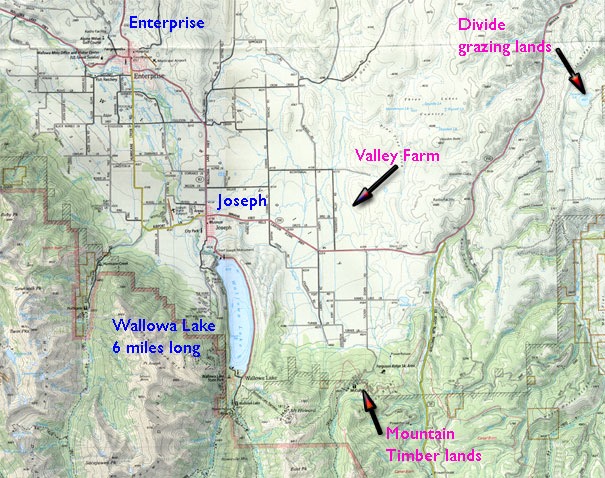
Farm (pink), Back Hills Grazing Land (pink and teal)
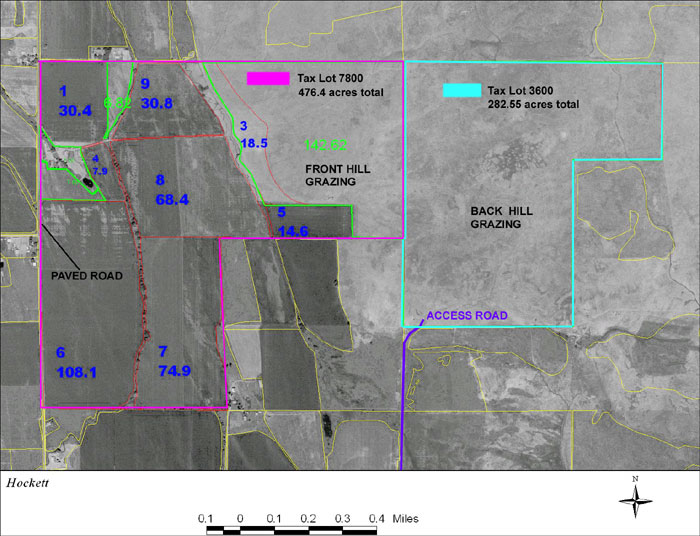
The Divide Grazing Lands
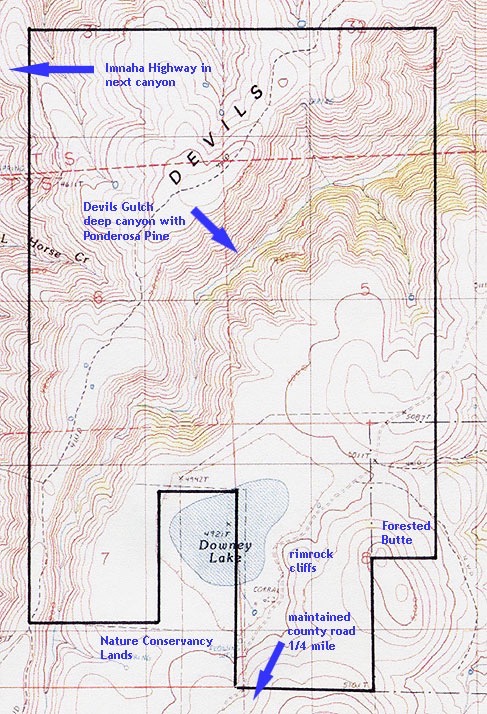
Timberland on McCully Creek, Mt. Howard
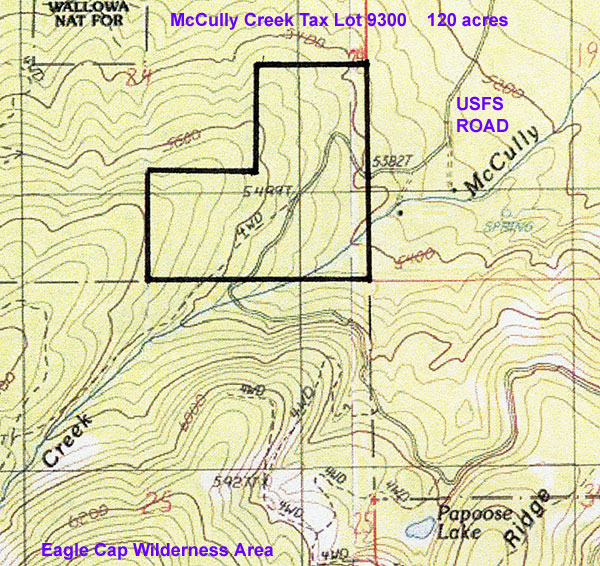
All together the lands were about 3,000 acres which was a medium sized operation in the 1950-60 period. Of course maps are not very interesting if you don’t have in mind the natural world described by those maps so here are some images of the property.
July, Barnyard and East Fields (looking West)
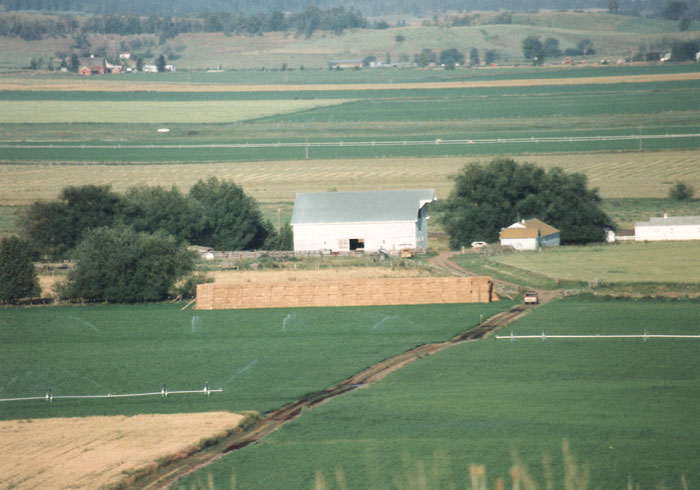
Early Summer, From Back Field, Looking West at Mt. Joseph

The Barnyard With Buildings
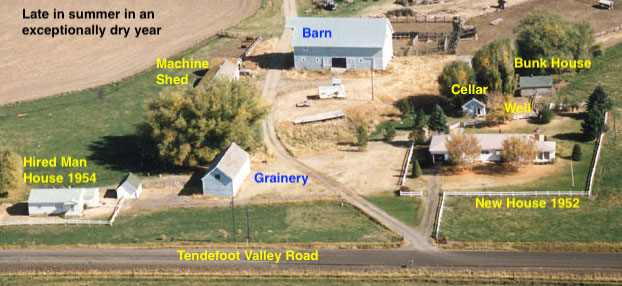
The Barn, one of the largest in the County, built for horse teams in the 20’s/30’s

Hayloft, usually fully stacked to the upper horizontal with hay in the winter
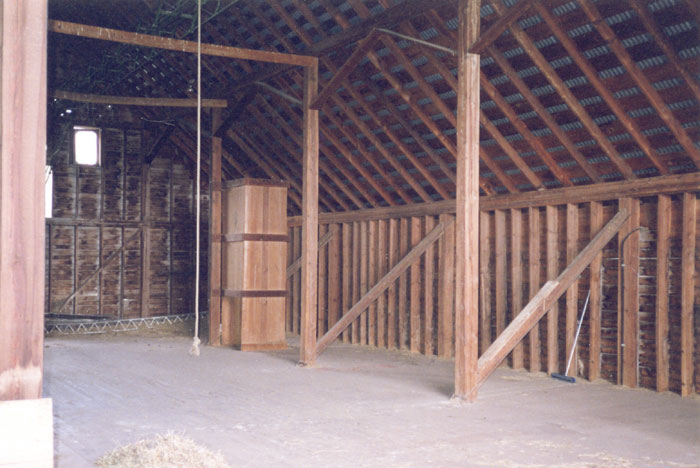
Late Summer, Pond South of Main House
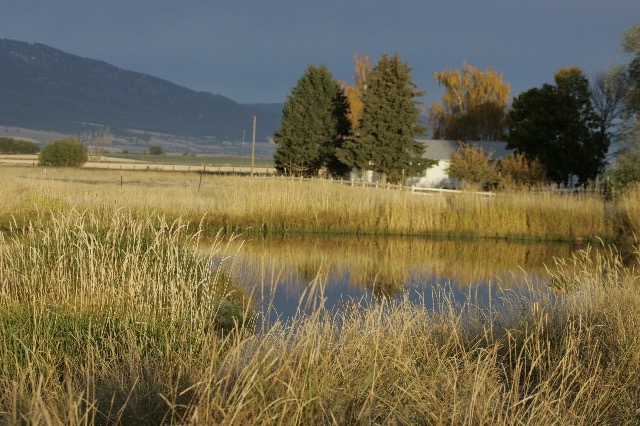
Mid Summer, Mountains From Neighbor’s Farm
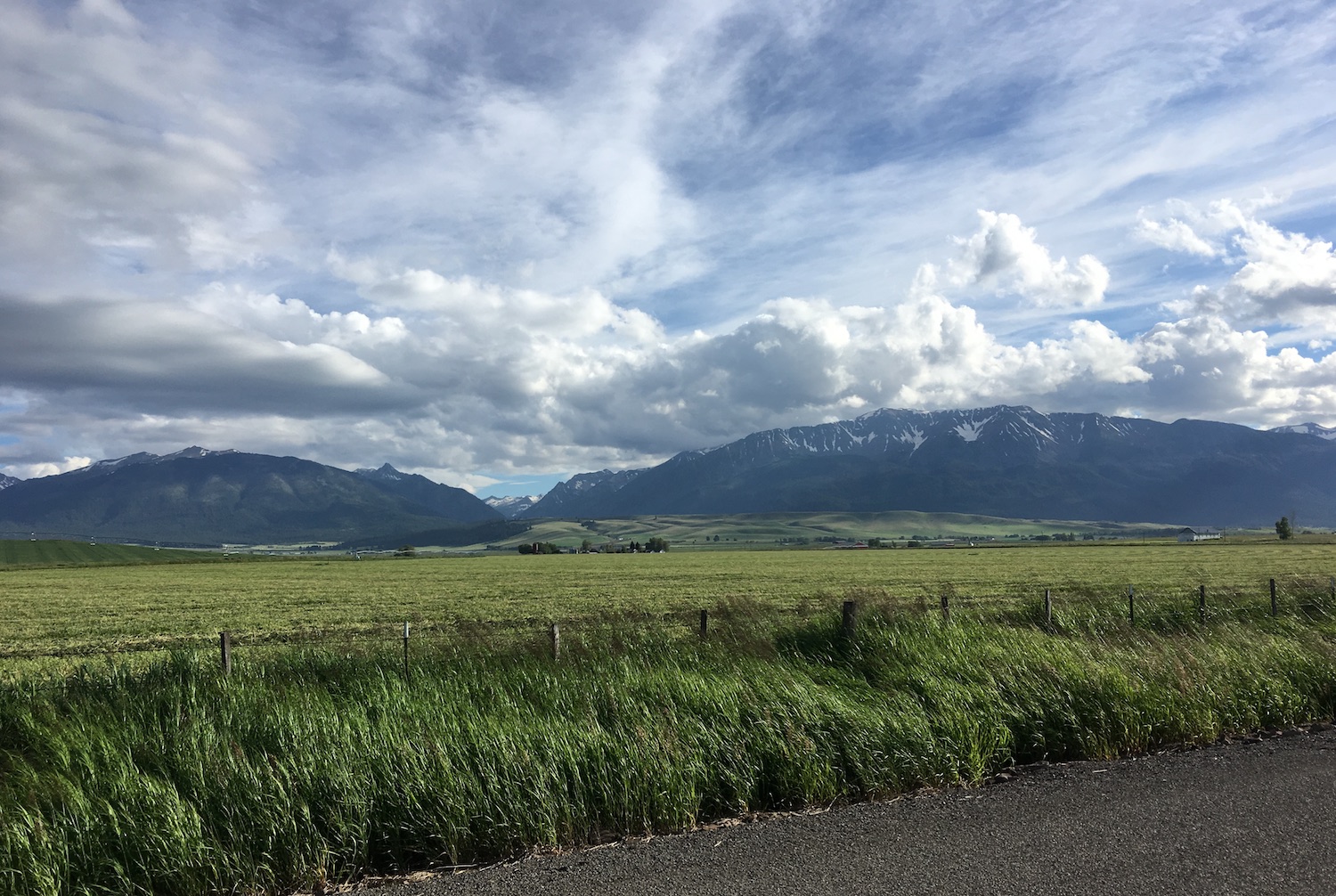
Timberland on Mt. Howard
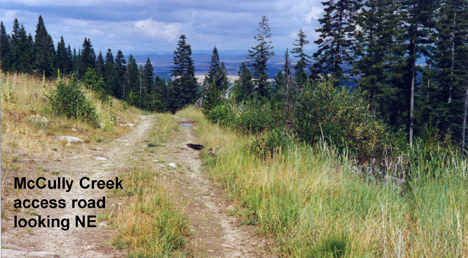
McCully Creek on the timberland
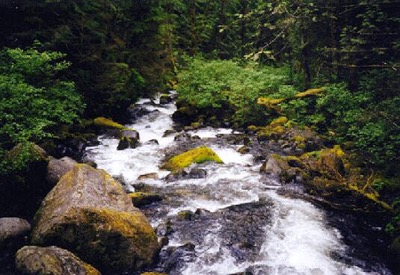
The Divide, one of the few high elevation, early spring bird nesting places in Oregon
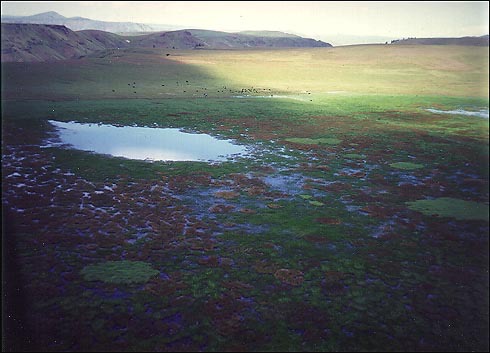
The Divide, remains of the original 19th Century homestead (it is 30 miles to the Mts.)
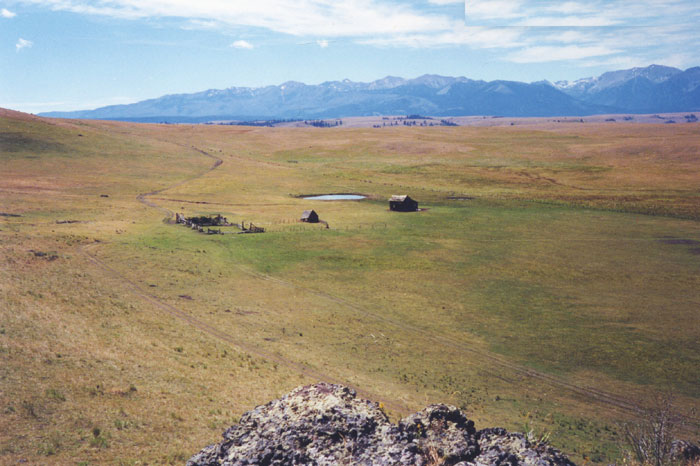
Devils Gulch on Divide property
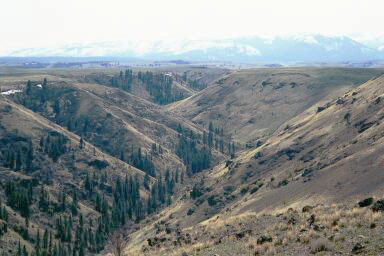
Elk in the lake at The Divide in early spring (not good for nesting birds)
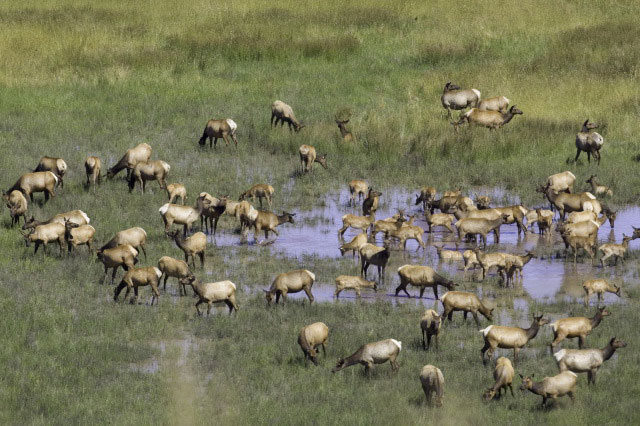
The Ranch In Operation
Now that you have a mental picture of the property, here is how this ranch worked. The ranch made money by selling milk (and cream), cattle, and grain for cash income. Hay and grain was also grown to feed to the cattle in the winter. In the 40-50’s self sufficiency in food was required so there were also milk cows for table milk and cream, pigs for pork, steers for beef at the table, and chickens for eggs and meat. In the summer fruit was picked from neighbors trees and canned for storage in the cellar for the winter months. And there was a large garden for vegetables. As grocery stores began carrying more fresh foods at lower prices this subsistence way of life faded away. The number of animals on the ranch included: 100-120 cows, 100-120 calves, 100-120 older steers (yearlings), 5-6 bulls for breeding, 5 horses, 15-20 milk cows, 10-20 hogs, 100 chickens, and some cow dogs and barn cats. The farm was a lively place.
Daily Routine-
The daily winter routine was as follows: arise at 5:30 and milk the cows, feed the chickens and pigs, feed hay to the cattle, feed the 4-H steers, eat breakfast, go to school, Dad loaded up the hay wagon for the next day, and then repeat the morning sequence in the evening.
The daily summer routine was as follows: rise at 5:30 milk the cows, irrigate the fields (later set sprinkler pipe), feed small animals, eat breakfast, grease, oil, and gas up the tractors, hook up your implement (mower, rake, baler, summer fallow harrow), and head out to the field until 11:45, return for lunch, gas up again, head out to the field until 5:30 pm, eat, do evening chores again.
Seasonal Sequence was as follows:
Winter- all the animals are fed on the farm by hay and grain crops grown in the last summer/fall season; new calves are born in the winter (late February).
Spring- grass begins to grow in April and the cattle are put out onto the back hill to graze, feeding hay stops; in April the ground unfreezes and is tilled for planting, wheat and barley are planted in late April or early May (after late freezes are no longer expected); while the new grain and grass shoots begin poking up irrigation ditches had to be plowed into each field to carry water to the new crops (no sprinkler pipe systems yet); Dad would take his shovel and go out each morning and night to direct the water from the main river diversion boxes (dams) into the smaller channels and out across the fields; the calves need to be branded, vaccinated, and the males castrated; in May the cattle are moved off the Back Hill and are driven in a two day cattle drive out to The Divide for summer pasturing.
Summer- in June the crops begin to mature and the fields are very full with bright green wheat, barley, alfalfa, and grass hay (later in the early 60’s with eating peas); by July 4th the first hay crop is ready to cut; all three tractors and the old jeep are fired up at 7:00 am each day as Mervin Horner and three kids head out to the fields to mow, rake, and bale the hay crops then stacking the bales in large hay stacks; once the first hay cutting is in, irrigation begins again; by August 10 the second hay crop is ready and is brought in; irrigation stops; the grain is just starting to turn a little golden. Occasionally someone has to go to the Divide and check on the cattle, take out salt blocks, and see if the water ponds are full. In the early 50’s we had large hay crews of hired hands to handle all the bales. With mechanization it was just our regular year round hired man Mervin and us kids.
Fall- in September it is the annual Labor Day cattle auction and the two year old steers are rounded up on The Divide and driven to Enterprise to be sold; the cows, calves, and bulls are still out on The Divide; the horses are on the back hill; the grain is still becoming full and golden, not yet ripe; school starts but there are morning and evening chores; Dad begins to get the combine and grain equipment ready for harvesting; early October the grain is ready to harvest and Dad drives the combine while we are at school, emptying it into the grain truck; as soon as we get home we head for the fields to drive the now full grain truck to the granary in the barnyard and auger it up and into the storage rooms (sometimes it is driven to town and given to the grain elevator there, depends on price); with the grain in, maintenance begins on buildings and fences; in late December (in a late snow year) the cattle are rounded up on The Divide and driven into the farm (if it is an early snow year they are driven in after Thanksgiving); winter feeding begins again.
This cycle occurs every year with slight changes as new technology becomes available but it is basically the same during the 50’s and then changes quickly in the 60’s with mechanization and greater capital invested in new technologies and the family farm concept starts to erode. The fifties was a golden era where prosperity had arrived (after The Depression and WWII) but mechanization has not yet changed basic farm life.
==================================================================
Sale of The Ranch
In 2003 the ranch LLC board voted to sell the ranch. The sale was not completed until 2008.
In 1962 Dad suffered a grand mal epileptic seizure and from that point on exhibited frequent petit mal seizures (not completely debilitating). Because of this disability by the mid-sixties the folks had retired and rented the croplands to a neighbor Gerald Sandlin who farmed the place for many years until he retired. Then Leroy Graning leased it for two years until he died, and thereupon his son Bill Graning leased it up until Dan Butterfield leased it in the fall of 2007. The Butterfield’s still lease it in 2023 from the new owners. The range land at the Divide was leased to several people during this period. The timberland was never leased out.
From the mid sixties up until the early 2000’s David, Clyde, and Roger were busy elsewhere with their careers. John was still at the ranch until the mid seventies. In 1995 the ranch was incorporated as part of a tax planning effort and stock was divided equally among Mom and Dad with the provision that annual stock gift over to the four children would begin that year. In 1999 Dad passed away and Mom was in steady decline mentally.
In 2002 Mom passed away and in September 2003 the LLC Board voted to sell the ranch. The ranch was too large to sell as one piece so it was sold to different parties. The farmland and back hill went to 3 parties, the Divide to another, and the timber land to a fifth party. The LLC document was structured in such a way that if one of the sons wanted a property they would have to come up with the funds within the year. None of us had the funds so it was decided to sell.
The grandchildren enjoyed many years of visiting the folks on a place that had emotional significance in their lives. While the folks were alive this was a time of good memories. However, the ranch was really run by the renters using their newer equipment. Our equipment had long since rusted away and become useless. Even when renting the ranch out there are numerous tasks that require the sweat of the brow to complete them (which are not the responsibility of the renters): painting buildings, building fences, repairing and replacing plumbing, furnaces, electrical, etc. If you always pay someone else to do these then you end up broke at the end of each year, saving nothing.
A 3,000 acre farm and cattle ranch is not a place for urban vacationers to visit once a year. It simply does not work that way; there is always something that needs to be done. There are several friends who got tired of all the work on their parent’s farms and ranches and sold them to be free of the constant need to work at maintaining them. If you don’t live on a ranch you own, you will find it a constant burden to return from the city and spend all of your free time working on old buildings and structures. The older you get the less enjoyable this becomes.
Once the folks were gone it was simply a matter of time until those of us who had other interests and responsibilities in life would decide to sell the ranch and be free of the burden to run it. There is a tremendous degree of nostalgia attached to rural land and it is not easy to part with it. Selling was an emotionally draining process but the correct decision.
—————————————————————————————
See the forthcoming chapter Prairie Creek 1946-60 for a detailed description with photos of the working ranch and living in Wallowa County in that period.